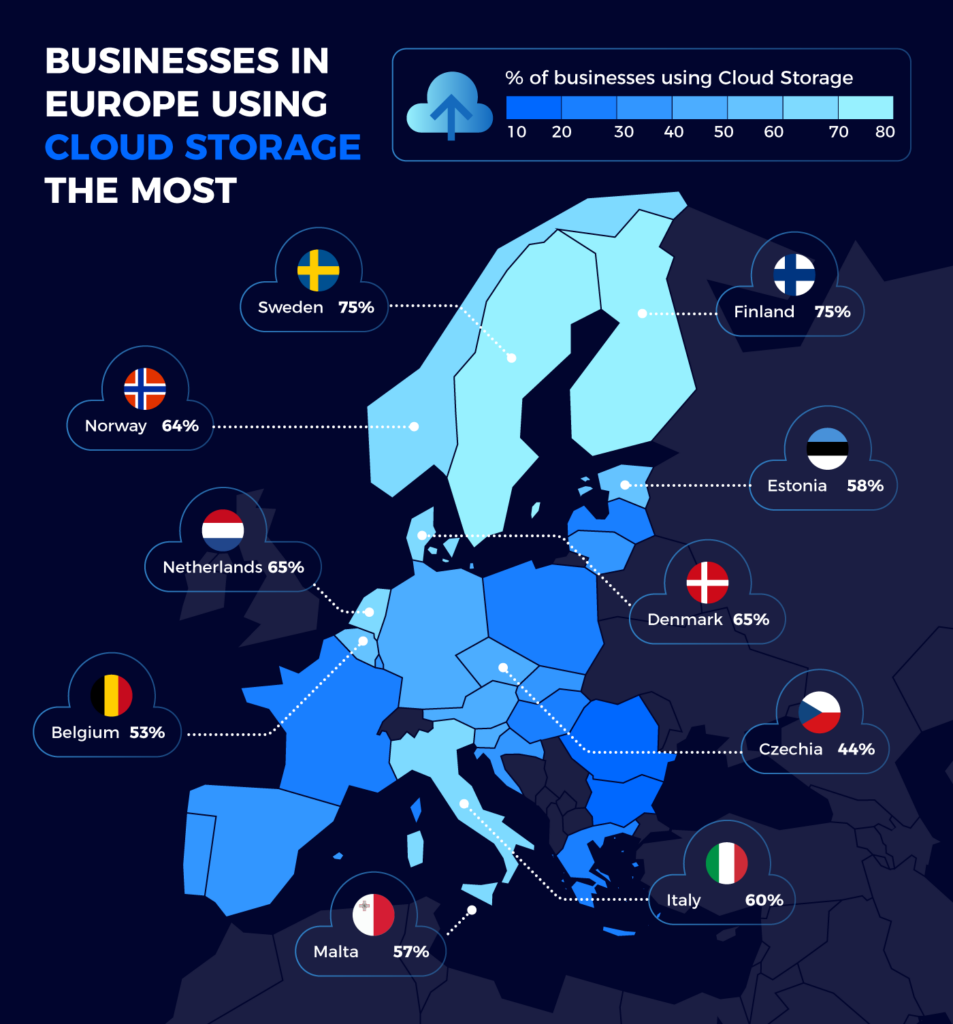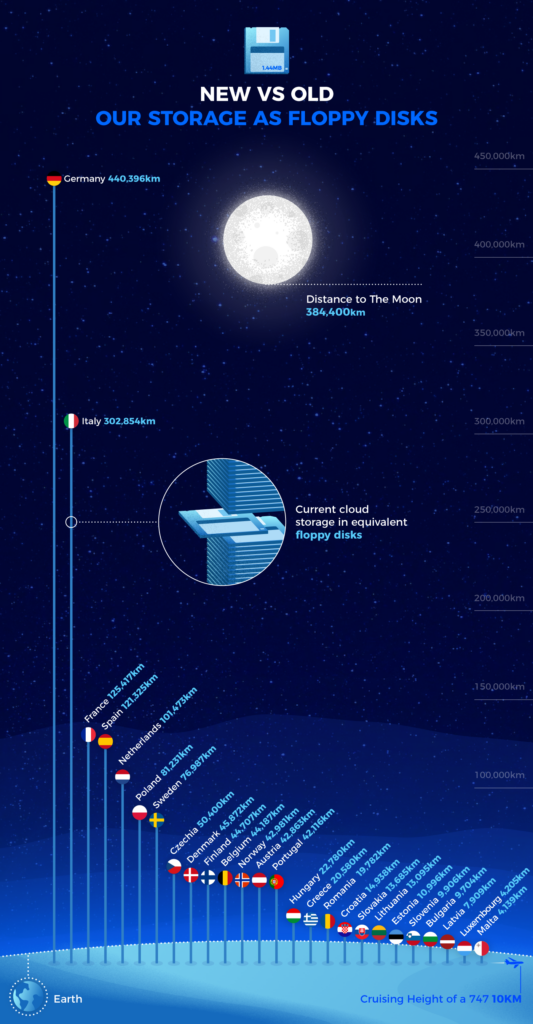From day to day, the vast majority of people likely do not consider the concept of cloud data storage, however, the reality is that cloud data storage hosts many of the platforms and businesses that we use, from video streaming services to the data of entire companies. Prior to the advent of cloud data storage, companies had to store all of their data on their own hard drives and servers, limiting scalability and slowing success. But it’s not just success at stake, former data storage solutions left themselves open to security breaches, data loss, and poor accessibility. However, that’s not to say that cloud data storage is without its own unique set of challenges.
In light of this, Distrelec wanted to visualise the cloud data storage of European businesses, in a way that shows just how vast their data actually is. As we’ve moved beyond the days of businesses having to store precious data on hard drives, internal servers and even floppy disks, it can be easy to forget how much data is stored. Ultimately, our study found that the data in the cloud reaches stratospheric heights when visualised in the format of floppy disks, using data that suggests a floppy disk can hold 1.44 MB of data and then stacking this flat based on a 3.33mm depth. For context, all of the data of the countries we studied would reach higher than the cruising height of a Boeing 747 (10km, or over 30,000 ft), with the lowest result in our study, Malta, reaching 400 times that.
First of all, we wanted to analyse which countries were using cloud data storage the most, before going a step further and visualising this in terms of the space that can be attributed to it.

When it comes to cloud data storage usage, it’s perhaps unsurprising to see that the Nordic regions rank highest for penetration within enterprises, with Sweden and Finland both seeing a 75% usage rate across businesses, Denmark seeing 65% and Norway seeing 64%. The region is fertile for technologically-enabled businesses, and regularly acknowledged for their entrepreneurship, innovation and high mobile and broadband penetration, resulting in a climate that serves high-growth businesses well.
The Netherlands also ranked highly in terms of cloud data utilisation across businesses, seeing a rate of 65% of businesses storing their data there. This correlated to 34,739 businesses and resulted in overall usage stacking the 5th highest (101,475 km) when it came to visualising the data as floppy disks. To contextualise, this equates to over 10,000 times the cruising height of a Boeing 747.
Italy is home to 112,598 businesses using cloud data storage, which is equivalent to 60% of the total number of businesses across ranges 10-19 employees, 20-49 employees and larger corporations with 50-249 employees. The country also placed second in our study when it came to visualising cloud data usage in floppy disk format.
Eastern Europe is also home to countries with some of the highest cloud data storage penetration across businesses, with Czechia and Estonia both ranking within the top 10. Estonia saw a penetration rate of 58%, equating to 3,849 businesses in total, while Czechia saw a rate of 44% which corresponded to 17,299 businesses. When visualised in floppy disk format, the data of Czech businesses (50,400 km) towered above that of Estonia (10,966 km), perhaps surprising given that Czechia places below EU averages in the DESI index, while Estonia places above, however this can be attributed to the difference in the overall number of businesses in each respective country.

Placing first in our study was Germany, with a total requirement of 190,441.5 TB of cloud data storage based on the number of businesses operating there. When broken down into the equivalent in floppy disks, this would reach a height of 440,396 km, 55,996km higher than the moon and over 5500 times the cruising height of a 747 airliner. 42% of enterprises in Germany were using cloud data storage, which corresponded to 158,355 businesses in total, of varying sizes and storage requirements. While Germany had a higher number of businesses using the cloud across the board, the country lays claim to 50,930 large businesses (50-249) with higher storage requirements, more than Italy and France combined. They also had more medium businesses (20-49 employees) than both countries combined, as well as a slightly higher number of small businesses, contributing to the vast differences in storage visualisation results.
In the second position lies Italy, with business storage requirements of 130,964 TB, reaching 302,854 km from the Earth. While the country’s data usage didn’t quite reach the moon, it still reaches over two-thirds of the way there.
Placing third was France. Here, we see a stark drop off in cloud data storage usage, with the country using 54,235 TB of storage, less than half of that which Italy used. This corresponds to 125,417km of data storage when visualised as floppy disks, almost one-third of the way to the moon. Over a quarter of French businesses (29%) were flagged as using cloud data storage solutions, totalling 45,152 businesses across various sizes and industries.
Despite ranking within the top 10 for cloud storage penetration across businesses, Malta placed the lowest when it came to visualising the extent of this data in terms of floppy disks. The primary reason for this is due to a lower overall number of businesses within the country, with just 1,451 businesses using cloud storage services, in comparison to countries like Romania which has a 14% penetration across businesses, but a higher number of businesses overall.
Ultimately, the phrase out of sight out of mind definitely applies to cloud data storage, with many entrusting important documents and files to a system that would take up stratospheric amounts of space if it were to be stored in formats of the past. This study highlights the areas in Europe that would contribute to this space.
———————————————————————————————–
Methodology
We used data from Eurostat to find the total number of businesses in each country across varying sizes, applying the percentage of those using cloud data storage to work out a total in each range.
Based on the assumption that a small/midsize business requires 1 TB of cloud data storage, and a large business requires 2-3 TB of storage, we then calculated the potential usage across European businesses.
We worked with data that showed the capacity of floppy disks that were formerly used (1.44 MB) and applied this to the cloud data storage utilised by businesses, using generic floppy disk dimensions to calculate this in terms of height.











